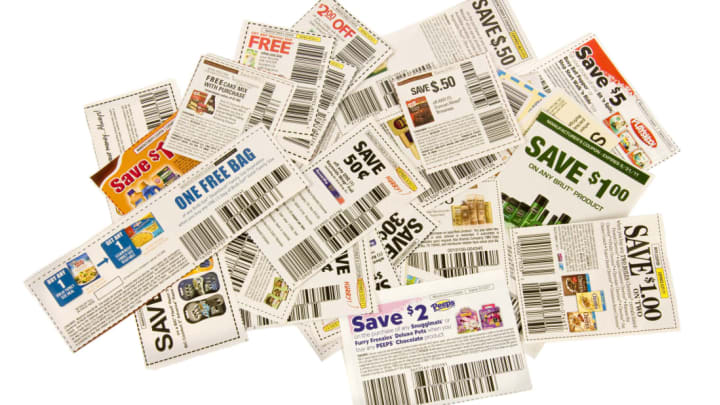Why Are Coupons Worth 1/100th of a Cent?
By Ethan Trex

The next time a coupon shows up in your mail, take a look at the fine print. There’s a pretty good chance it will read something to the effect of “Cash Value 1/100th of a cent.” Why in the world is that writing on there? And are 10,000 copies of this coupon really worth a whole dollar? Let’s take a look at this coupon quirk.
Putting a Stamp on Customer Loyalty
Before we can answer the coupon-value question, we need to take a peek into a seemingly unrelated footnote in the history of commerce. Let’s talk about the mostly forgotten practice of businesses handing out trading stamps with purchases.
Trading stamps first found their way into merchants’ registers in the 1890s. When customers made a purchase, stores would given them stamps that reflected how much they had spent; a common exchange rate was one stamp for every dime spent on merchandise. Once a customer had saved up enough stamps – often over a thousand – they could swap them for something from the stamp company’s catalog, like a toaster or a clock.
The trading stamps were a runaway success. Supermarkets, gas stations, and department stores would advertise that they gave away a certain brand of stamps to help lure customers in, and the customers could then lick and paste their saved stamps to get “free” merchandise. Everyone was happy, and the system flourished. At one point in the 1960s, S&H Green Stamps printed more stamps each year than the Postal Service did. The circulation of the company’s catalog topped 30 million. The big stamp makers like S&H even built brick-and-mortar “redemption center” stores around the country.
As any economist worth his cost function can tell you, though, the toasters and vacuum cleaners that customers got weren’t free at all. Merchants had to pay for the stamps they gave away, and the cost of the stamp obviously got passed along to the customer in the form of higher prices.
Even in the early days, it didn’t take long for customers to figure out that the system wasn’t quite as rosy as merchants made it out to be. By 1904 New York had enacted laws that forced stamp makers to put a cash face value on each stamp that would enable consumers to bypass catalog redemptions and get money back for their stamps. Other states followed suit.
As one might guess, the individual stamps didn’t get princely face values. A 1904 New York Times piece noted that most stamp makers were given the value of “one mill,” or 1/10th of a cent. That valuation meant that a customer with a full book of 1,000 stamps could redeem it for a dollar. The same piece noted, though, that a customer who used the stamp makers’ catalogs could probably get an item worth three or four dollars for the same number of stamps, so the cash-redemption idea never really took off with most shoppers.
What happened to trading stamps? Their popularity peaked in the 1960s when nearly 80 percent of American households saved stamps, but within a decade the craze had died. Manufacturer coupons that shaved money off of items’ prices became more popular as inducements to get shoppers into stores, and the fuel crisis of the early 1970s sapped away the stamps’ large market at gas stations.
So What Does All This Have to Do With Coupons?
At first glance, coupons and trade stamps wouldn’t seem to have all that much in common. After all, coupons lower the price of an item, while the beef with trade stamps was that they passed a hidden (and often unwanted) cost along to consumers. But some states legally lump trade stamps and coupons in together, so coupons distributed in these states have to bear some printed cash redemption value.
According to the Association of Coupon Professions, only three states require this declaration of redemption value: Indiana, Utah, and Washington. Since many coupons are designed for national distribution, though, the redemption value ends up printed on all of them. As with the old trade stamps, it doesn’t really matter how infinitesimal the stated value is as long as it’s not zero. Thus, you see coupons that are worth 1/10th, 1/20th, or 1/100th of a cent.
So Can I Round Up 20 Coupons and Get a Penny?
In theory, yes. It’s hard to find reliable, concrete examples of someone schlepping in a hundred coupons to swap them out for a penny, but the web is full of anecdotes in which people “test the fine print” by trading in a giant stack of coupons for their face value at the supermarket. In all likelihood, though, you’d need to mail the coupons to the issuing company, which is a pretty lousy financial proposition given the price of stamps.
If you’re sitting on a big pile of Shake N Bake coupons, you might as well give it a try; your supermarket will probably gladly surrender a penny to ensure you don’t make a scene.